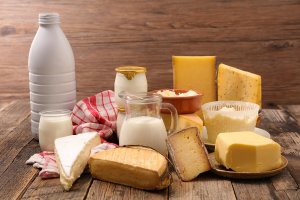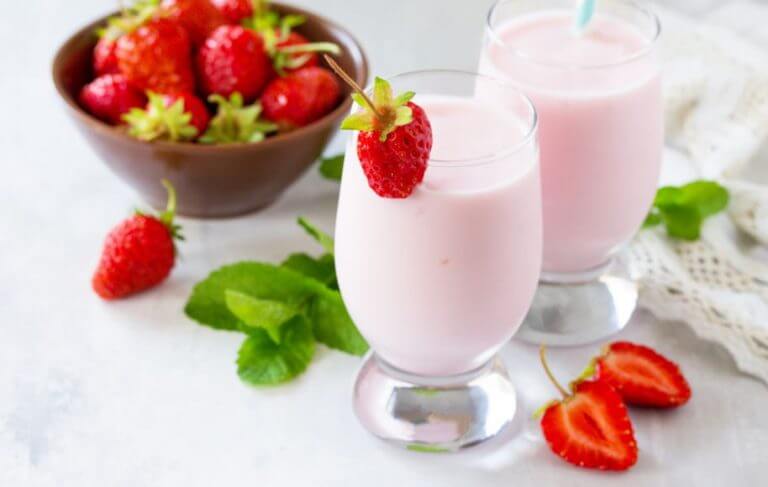Everything you Need to know about Dairy Products

When we talk about dairy products, we refer to products that are made with milk. All mammals produce milk to feed their offspring, but humans only consume milk that comes from cows, carabaos (Asian buffalos), sheep, goats, camels, and yaks.
According to data from the Food and Agriculture Organization of the United Nations (FAO), global milk production during 2013 reached 753.036 million tonnes. Cow’s milk has the biggest production percentage (83%), followed by buffalo milk (12.9%) and goat’s milk (2.4%).
The nutritional composition of dairy products may vary a lot, depending on what kind of animal they come from. For example, sheep milk has a higher protein content (5.6 grams per 100 grams) than cow’s milk (3 grams per 100 grams) and it also contains more calories.
Milk contains a protein with a very high biological value, and it covers a big percentage of our daily calcium needs. It’s also a good source of vitamins and minerals.
Dairy products
According to the Codex Standard, a dairy product is a product obtained through milk processing. It can contain food additives and other ingredients that are functionally necessary for its elaboration. Therefore, we can distinguish between the following kinds of dairy products:
Fermented milk
The milk goes through a fermentation process with microorganisms that are different from those used in yogurt production. Kefir is an example of these products.
After pasteurization, they add specific microorganisms to the milk. These microorganisms use the nutrients in the milk to produce a specific taste and texture. You should keep fermented milk in the fridge, as they contain live microorganisms.

Yogurts
Yogurts have a chemical composition that’s very similar to that of milk, but with different organoleptic characteristics. These are some of the features that stand out:
- They’re easier to digest and assimilate than milk because they contain hydrolyzed proteins.
- Yogurt contains less lactose than milk because the fermenting microorganisms it contains digest the lactose during the production process. That’s why some people who are lactose intolerant have no problem eating yogurt.
- They have a probiotic effect: yogurt contains live microorganisms that colonize your intestines, improve your gut flora and strengthen your immune functions.
Cream
The cream is produced by centrifuging raw milk and separating the fat. It’s the concentrated fatty matter in milk. The cream contains one-third of the protein in milk and half the lactose. Be careful with this product if you’re lactose intolerant!
It’s a high-calorie product, which is why we recommend consuming it with moderation. This dairy product is especially rich in fat-soluble vitamins, specifically in vitamin A and D.
Butter
Butter is usually present in a lot of traditional breakfasts, but how is it made? This food comes from curing pasteurized cream. The curds then go through a whipping and kneading process to obtain the final product.
Just like cream, butter also contains a great number of lipids and fat-soluble vitamins. At the same time, it has a much lower protein content.
When you heat up butter to over 194°F, it burns and forms a chemical compound known as acrolein. This substance has an unpleasant smell and taste.
Cheese, the star among dairy products
We make cheese by coagulating milk. After an acidic coagulation process, we end up with whey and clotted milk. From whey, we produce curd cheese, and from clotted milk, we can make other types of cheese.
The different cheese varieties depend on the microorganisms that we use to acidify the cheese and the maturing period of the product. Depending on the elaboration process, we can classify the different types of cheese as:
- Fresh and white pasteurized: when it’s ready to eat after the elaboration process.
- Mature or fermented: cheeses that must stay under certain conditions before eating them to obtain some physical and chemical changes.

We can also classify them by their fat content:
- Skim cheese: contains no more than 10% fat.
- Low-fat cheese: they contain around 10% and 25% fat.
- Half-fat cheese: their fat content is around 25% and 45%.
- Full-fat cheese: they contain between 45% and 60% fat.
- Extra-fatty cheese: they contain no less than 60% fat.
Cheese usually has less lactose than milk. The longer the maturing period is, the less lactose they’ll contain. They also contain a lot of minerals such as calcium, phosphorus, and zinc.
In summary, there are a lot of different dairy products. You can include them in your diet to ensure you have a complete nutrition plan. They contain a lot of nutrients, but you must eat them in moderation to avoid an excess of certain substances such fat.
When we talk about dairy products, we refer to products that are made with milk. All mammals produce milk to feed their offspring, but humans only consume milk that comes from cows, carabaos (Asian buffalos), sheep, goats, camels, and yaks.
According to data from the Food and Agriculture Organization of the United Nations (FAO), global milk production during 2013 reached 753.036 million tonnes. Cow’s milk has the biggest production percentage (83%), followed by buffalo milk (12.9%) and goat’s milk (2.4%).
The nutritional composition of dairy products may vary a lot, depending on what kind of animal they come from. For example, sheep milk has a higher protein content (5.6 grams per 100 grams) than cow’s milk (3 grams per 100 grams) and it also contains more calories.
Milk contains a protein with a very high biological value, and it covers a big percentage of our daily calcium needs. It’s also a good source of vitamins and minerals.
Dairy products
According to the Codex Standard, a dairy product is a product obtained through milk processing. It can contain food additives and other ingredients that are functionally necessary for its elaboration. Therefore, we can distinguish between the following kinds of dairy products:
Fermented milk
The milk goes through a fermentation process with microorganisms that are different from those used in yogurt production. Kefir is an example of these products.
After pasteurization, they add specific microorganisms to the milk. These microorganisms use the nutrients in the milk to produce a specific taste and texture. You should keep fermented milk in the fridge, as they contain live microorganisms.

Yogurts
Yogurts have a chemical composition that’s very similar to that of milk, but with different organoleptic characteristics. These are some of the features that stand out:
- They’re easier to digest and assimilate than milk because they contain hydrolyzed proteins.
- Yogurt contains less lactose than milk because the fermenting microorganisms it contains digest the lactose during the production process. That’s why some people who are lactose intolerant have no problem eating yogurt.
- They have a probiotic effect: yogurt contains live microorganisms that colonize your intestines, improve your gut flora and strengthen your immune functions.
Cream
The cream is produced by centrifuging raw milk and separating the fat. It’s the concentrated fatty matter in milk. The cream contains one-third of the protein in milk and half the lactose. Be careful with this product if you’re lactose intolerant!
It’s a high-calorie product, which is why we recommend consuming it with moderation. This dairy product is especially rich in fat-soluble vitamins, specifically in vitamin A and D.
Butter
Butter is usually present in a lot of traditional breakfasts, but how is it made? This food comes from curing pasteurized cream. The curds then go through a whipping and kneading process to obtain the final product.
Just like cream, butter also contains a great number of lipids and fat-soluble vitamins. At the same time, it has a much lower protein content.
When you heat up butter to over 194°F, it burns and forms a chemical compound known as acrolein. This substance has an unpleasant smell and taste.
Cheese, the star among dairy products
We make cheese by coagulating milk. After an acidic coagulation process, we end up with whey and clotted milk. From whey, we produce curd cheese, and from clotted milk, we can make other types of cheese.
The different cheese varieties depend on the microorganisms that we use to acidify the cheese and the maturing period of the product. Depending on the elaboration process, we can classify the different types of cheese as:
- Fresh and white pasteurized: when it’s ready to eat after the elaboration process.
- Mature or fermented: cheeses that must stay under certain conditions before eating them to obtain some physical and chemical changes.

We can also classify them by their fat content:
- Skim cheese: contains no more than 10% fat.
- Low-fat cheese: they contain around 10% and 25% fat.
- Half-fat cheese: their fat content is around 25% and 45%.
- Full-fat cheese: they contain between 45% and 60% fat.
- Extra-fatty cheese: they contain no less than 60% fat.
Cheese usually has less lactose than milk. The longer the maturing period is, the less lactose they’ll contain. They also contain a lot of minerals such as calcium, phosphorus, and zinc.
In summary, there are a lot of different dairy products. You can include them in your diet to ensure you have a complete nutrition plan. They contain a lot of nutrients, but you must eat them in moderation to avoid an excess of certain substances such fat.
All cited sources were thoroughly reviewed by our team to ensure their quality, reliability, currency, and validity. The bibliography of this article was considered reliable and of academic or scientific accuracy.
- Harold Mc Gee. 2010. Leche y productos lácteos. En: La cocina y los alimentos. Enciclopedia de la ciencia y la cultura de la comida.
- FAOSTAT, 2016. Disponible en: http://www.fao.org/faostat/es/#data
- Norma general del codex para el uso de términos lecheros. Codex Stan 206-1999
This text is provided for informational purposes only and does not replace consultation with a professional. If in doubt, consult your specialist.








